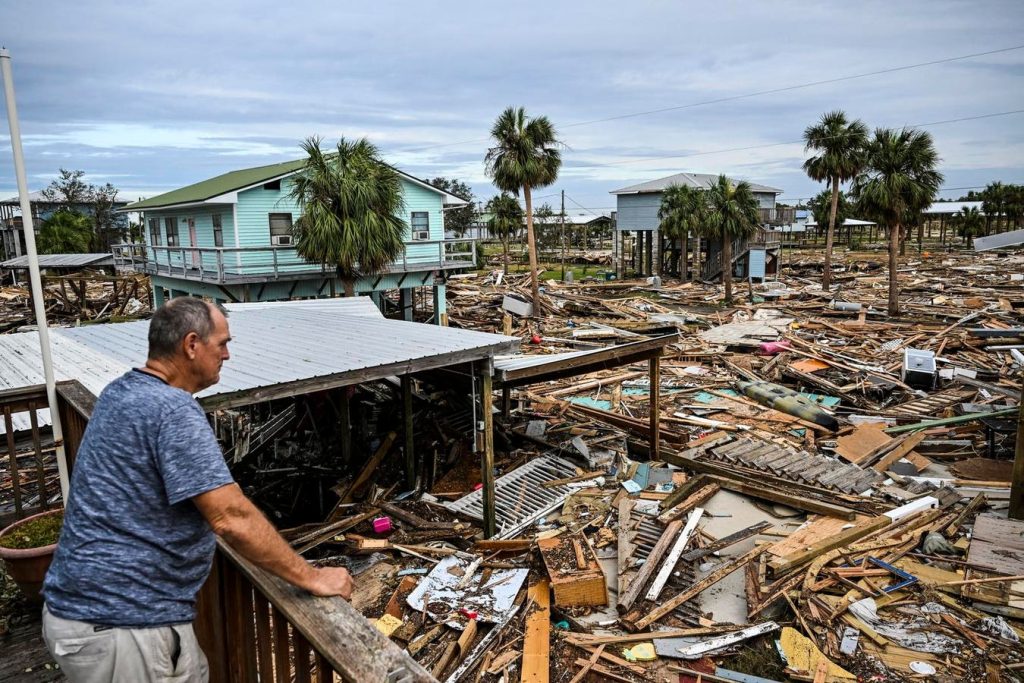TOPSHOT – David Hester inspects damages of his house after Hurricane Helene made landfall in … [+]
With the federal student loan on-ramp over as of September 30, now is an awful time to be struggling with bills. The 12-month on-ramp period protected borrowers from the worst consequences of missed payments and defaulted loans, including potential damage to their credit scores.
With this short-term fix in the rearview mirror, borrowers with late payments may soon see their credit scores drop and face other ramifications like wage garnishment and seizures of tax refunds.
Borrowers impacted by Hurricane Helene may find some relief when it comes to their student loan payments. If you are facing hardships caused by the hurricane — including displacement, a temporary loss of income, or an injury that left you unable to work — here are some options you may have.
Hurt By Hurricane Helene? Here Are Your Student Loan Options
According to Paul Dieken, director of financial aid at Pomona College, current students pursuing a degree who have been impacted by the hurricane should contact their college financial aid office to see if they can appeal their offer of financial aid. Doing so may help them qualify for additional aid based on changes to their financial situation, and the school’s financial aid office will likely offer assistance when it comes to the specifics of filing an appeal.
For those people who are in repayment on federal student loans, Dieken says they should contact their loan servicer and ask if they qualify for a disaster relief administrative forbearance.
According to the U.S. Department of Education, borrowers who live in a FEMA-designated disaster area may be able to qualify for a disaster relief administrative forbearance that postpones their loan payments for up to 90 days. Interest doesn’t capitalize during this type of forbearance either, which means loan balances won’t grow during the 90 days required payments are paused.
There are other types of forbearance for federal student loans to consider as well, including general forbearance. Borrowers can apply for a general forbearance with their loan servicer if they are facing financial complications, a job loss or loss in income, unexpected medical expenses, or other consequences of Hurricane Helene.
This type of forbearance works for Direct Loans, Federal Family Education program loans, and Perkins loans and generally lasts for up to 12 months at a time. Students can also request an extension of their general forbearance if their situation hasn’t improved. However, a cumulative limit of three years applies for all months spent in general forbearance.
According to Studentaid.gov, deferment of federal student loans is another option to consider. Deferment can be a better choice since some loans (specifically subsidized student loans) do not accrue interest during deferment, whereas interest accrues during general forbearance periods.
The U.S. Department of Education lists a range of situations when deferment could apply, and one of them is “experiencing economic hardship.” Deferment can also be achieved during periods of unemployment.
Note that you’ll have to submit documentation and proof to qualify for deferment or forbearance with federal student loans. In either scenario, you’ll start the process by reaching out to your loan servicer to find out how to apply and which documents you need to submit.
People who are in repayment on a private student loan should contact their lender to find out what options are available.
“Private lenders may offer their own forbearance plans, but each lender will be different, so borrowers will need to contact them to find out what is available,” says Dieken.
For example, private student loan lender Laurel Road offers general forbearance options for economic hardship, which could apply after a major hurricane. Laurel Road doesn’t share much information online on what it takes to qualify, but it does say its forbearance program can give borrowers anywhere from two to 12 months to get back on track with their student loan payments.
In any case, you have nothing to lose by calling your private student loan servicer to inquire about your options. You may be able to secure several months of paused payments to give you some time to catch up, but you won’t know unless you check.
Final Thoughts
If you’re losing income, you’ve lost your home, you’re currently displaced or all of the above, having to pick back up with federal student loan payments this month could be a major hardship.
You can also look into applying for one of the other income-driven repayment plans available for federal student loans (like PAYE or ICR). These plans aren’t as good as SAVE, which is currently blocked by the courts, but they can help some borrowers get a lower monthly payment each month.
For the most part, borrowers with federal student loans can start with reaching out to their loan servicer to inquire about options. This could be federal deferment or forbearance for federal student loans or a disaster relief administrative forbearance for borrowers who live in a FEMA-designated disaster area.
Individuals with private student loans can and should reach out to those companies to see what options they have, if any. While private student loans don’t have as many consumer protections as federal student loans, a surprising number of providers let borrowers skip monthly payments when disaster strikes.
